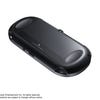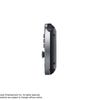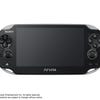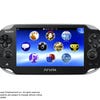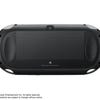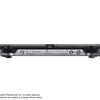PlayStation Vita Review
The ultimate hardcore gamer's handheld?
These days there are so many handheld devices available that allow you to play games on the move - small and large, cheap and expensive, buttons and touch - that it's a challenge to stand out from the crowd. Where do you put your focus? Judging by a fortnight with PlayStation Vita, even Sony's hardware designers couldn't make their minds up about that, because the initial impression is that they threw everything at the wall and everything stuck. The result is a handheld that can do pretty much anything. The good news for hardcore gamers is that in amongst all of that functionality are a few things that could - if the software follows - make this the best gaming portable ever.
PlayStation Vita isn't going to infest the world like iPad did two years ago, but it faces the same scepticism - that Sony is answering a question no one's asked. Apple's tablet quickly rose to that challenge by seeping into the gaps between other devices to become the best at things we forgot we wanted, and gamers may discover that Vita pulls a similar trick. Now you can sit on a train playing a new Uncharted adventure and it looks almost as good as the one at home, and crucially it feels the same.
"We need that second analogue stick - something that even Nintendo has belatedly acknowledged with its revisions to the 3DS - and it's here at last."
You can argue that we had that before with PlayStation Portable, but the truth is that we didn't. We need that second analogue stick - something that even Nintendo has belatedly acknowledged with its revisions to the 3DS - and it's here at last, and makes as profound a difference to handheld gameplay as anything since the original DS second screen and stylus. There is a lot to be said for simplicity in control, but core gamers need flexibility and precision, and Vita should be the most flexible and precise handheld console ever made.
This is a handheld with two analogue sticks, a traditional d-pad and face buttons, two shoulder buttons, PS (home), select and start buttons, independent volume controls and a power/sleep button, a 5-inch capacitive OLED touch-screen, a rear touch panel of the same dimensions, a built-in microphone, a headphone port, front and rear cameras, and dedicated AV, power, memory card and game card slots. You can add a sim card slot to that if you buy the 3G model.
It's big, too - bigger than the original PSP - but it's also thin and very light at just 263g (slightly over half a pound) and feels sturdy. The flaps for the AV cable and game and memory cards need a good bit of jimmying with a fingernail to access, and the only other moving parts that seem to hang off the unit are the squat, robust analogue sticks, slightly rubberised so your thumbs don't slip away but otherwise - along with the rest of the frontend furniture - discreet. The only slight drawback is with the face buttons, which are small and micro-switched rather than analogue, so they don't feel as comfortable as a DualShock, but you should quickly adapt.
Sony has caught up with its competitors in touch control quickly, too, with a fine capacitive screen that registers inputs as smartly as any other device I've held, allowing you to zip between screens, scroll around comfortably and respond to button and gesture prompts in Uncharted in a split second. Rear touch is similarly responsive, although a little harder to get your head around. The one criticism is that the screen smudges easily compared to modern smartphones.
That broad range of control inputs is reflected by a launch line-up that excites the senses more than any in recent memory. Many of the titles that lined up on 17th December in Japan were ports or adaptations of thoroughbred series like Everybody's Golf, Ridge Racer, Katamari, Virtua Tennis and Marvel vs. Capcom, but there was also a fabulous new instalment of Uncharted, and new titles Army Corps of Hell (a game where you use an army of goblins to assault your enemies, Pikmin-style) and Little Deviants (from UK-based Bigbig Studios), with the likes of WipEout 2048, MotorStorm RC and Gravity Rush (an intriguing physics-bending action game from Siren series designer Keiichiro Toyama) to follow in the next two months.
European PlayStation boss Jim Ryan has previously described the European Vita launch line-up as "comfortably the strongest line-up we've had for any platform launch... since the year dot", and while such statements are always liable to elevate the internet's blood pressure, this line-up is a great advert for the platform's potential. This is a system where you can find a twin-stick shooter like Super Stardust, or a third-person action-adventure game, or a quirky puzzle game where you push the ground up beneath your avatar like Little Deviants, delivered without compromise.
Vita doesn't attempt to compete with smartphones on portability - it's too big to be an 'everyday everywhere' device - but with this much functionality and this much raw graphical power, it is disappointing that it doesn't ape the smartphones' slightly more open approach to development. We never expected anything other than another walled garden console, but this is such an inviting set of specifications that it seems counterintuitive for a company with Sony's passion for creativity to keep it locked off to bedroom programmers and independent developers.
I played a lot of Uncharted over Christmas, but I also played a lot of Temple Run on iOS. An iOS system will never allow me to have the Uncharted experience - the controls will be wrong, even if the graphics catch up - but Vita could render Temple Run in its sleep, and denying games like that space on this platform because they don't fit an arbitrary price structure is strange logic. Gamers are prepared to buy games at a huge range of price points, from 69p all the way up to £100-plus Collector's Editions, and forcing us to buy games from vetted studios and only at premium tags will not unlock more of our money - we will just spend it in the smartphone app stores against which Vita supposedly isn't competing. Sony might counter that it is trying to assure quality, but that doesn't wash either - the only protection we need from bad products is technical QA, a well-designed and curated interface, and our common sense.
The same sort of old-school thinking that locks out independent development to all but the coddled few is apparent elsewhere in the Vita design. It's in the proprietary USB cable and lack of universal USB charging, it's in the absence of onboard memory, and it's in proprietary, mandatory memory cards that are sold separately. Sony has said that it intends to go after core gamers first with Vita before tackling the mass market, and perhaps we are tolerant enough to put up with these little niggles and tolls (we usually complain and then hand over our money anyway), but these things will do Vita few favours when it tries to capture attention further afield.
Leaving those concerns aside, PlayStation Vita's great selling point should be that it offers high-definition gaming experiences on the go with the same improving social features - like friend and messaging alerts, Trophies and "near", which looks like a fun way of benefitting from the installed base growing around you day to day, rather like 3DS' StreetPass - and the same diverse array of content. More than ever, this is a device that fits Sony's marketing slug: "It only does everything."
For now then, PlayStation Vita is potentially the most powerful and flexible gaming handheld ever, but it is already a fantastic one. It has been built on old logic, and it may not be a successful commercial venture - the knives are already out for it in some quarters - but it has already yielded some brilliant titles and Sony has a history of strongly supporting its own formats with a mixture of traditional and innovative software, while Vita's functional similarity to home consoles makes it very third-party friendly, so it feels like a safe bet providing nothing catastrophic happens to Sony itself.
If you find iOS and Android hardware restrictive and yearn for home console experiences on the go, then by rights this is where they should appear if they are still to be found anywhere in the years to come. Between PlayStation Vita and a rejuvenated Nintendo 3DS, hardcore gamers are now spoiled for choice when they leave the house. Long may that continue.
PlayStation Vita is due for release in Europe on 22nd February 2012 at £229 / €249 for the Wi-Fi model and £279 / €299 for the Wi-Fi/3G version. Look out for Digital Foundry's in-depth PlayStation Vita hardware analysis coming soon.



